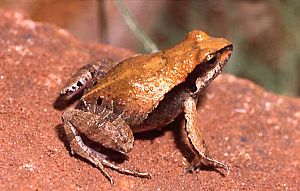Physalaemus gracilis facts for kids
Quick facts for kids Physalaemus gracilis |
|
|---|---|
 |
|
| Conservation status | |
| Scientific classification | |
| Synonyms | |
|
Paludicola gracilis Boulenger, 1883 |
The Physalaemus gracilis is a small and interesting frog species. It belongs to a group of frogs called the Leptodactylidae family. This frog is often called the "graceful frog" because of its scientific name, gracilis, which means graceful. It's a common sight in parts of South America.
Contents
Meet the Graceful Frog!
The Physalaemus gracilis is a type of frog that lives in several countries. These frogs are known for their ability to adapt to different places. They are not very picky about where they live. This makes them quite successful in their natural homes. Scientists first described this frog in 1883.
Where Does It Live?
You can find the graceful frog in the southern parts of Brazil. It also lives in Uruguay and nearby areas of Argentina. There's a good chance it might also live in Paraguay. These countries are all located in South America. The frog prefers warmer climates.
What's Its Home Like?
This frog likes to live near the edges of forests. It also enjoys the wide-open spaces of Cerrado grasslands. The Cerrado is a type of savanna habitat. It has lots of grass and scattered trees. What's cool about this frog is how tough it is. It can even live in places that humans have changed a lot. This includes areas that might be a bit polluted.
How Does It Grow?
Like many frogs, the Physalaemus gracilis starts its life in water. But it has a special way of laying its eggs. It builds something called a foam nest. These nests are like a bubbly raft floating on the water. The female frog lays her eggs inside this foamy mass. The foam protects the eggs from drying out. It also keeps them safe from some predators.
These foam nests are usually built in temporary pools of water. These are puddles or small ponds that might dry up later. Once the eggs hatch, tiny tadpoles emerge. They live in the water and eat small bits of plants. As they grow, they slowly change into froglets. This process is called metamorphosis. Eventually, they become adult frogs. They then leave the water to live on land.
Is It Safe?
Good news for the graceful frog! It is a very common species. It is found in many different places. This means it is not currently facing any big threats. Its population is strong and healthy. Scientists keep an eye on animal populations. They make sure species are not in danger. The Physalaemus gracilis is listed as "Least Concern." This means it is doing well in the wild.
See also
 In Spanish: Physalaemus gracilis para niños
In Spanish: Physalaemus gracilis para niños


